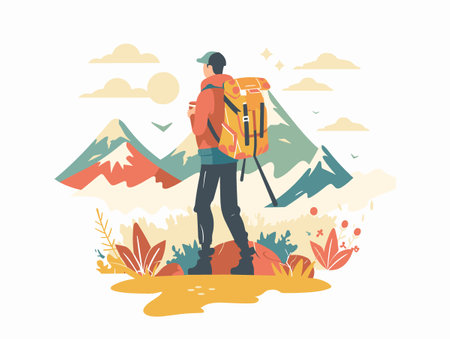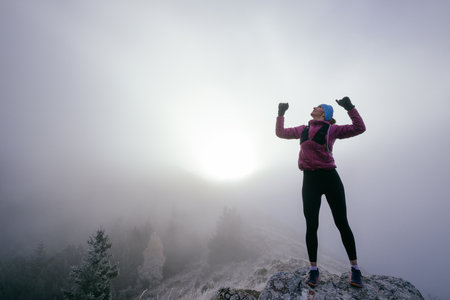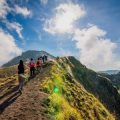Introduction: Why Water Safety Matters on the Trail
Every year, thousands of hikers and outdoor adventurers in the United States find themselves facing unexpected water emergencies—situations that can quickly turn a day hike into a life-threatening ordeal. According to the National Park Service, dehydration and water-related incidents are among the top reasons for search and rescue operations across America’s vast network of trails and national parks. In 2022 alone, more than 1,400 rescue missions were attributed to hikers suffering from heat exhaustion, dehydration, or getting lost without adequate water supplies. These numbers are not just statistics—they are real stories of people who underestimated the importance of water planning in the great outdoors.
In American hiking culture, hitting the trail is about adventure, self-discovery, and connecting with nature. However, it also means being responsible stewards of our own well-being. Hydration isn’t just about quenching thirst; it’s about ensuring your body has what it needs to regulate temperature, maintain energy levels, and make sound decisions in demanding environments. Water safety encompasses more than just carrying enough to drink—it includes knowing how to find safe water sources, understanding signs of dehydration or heat illness, and having a backup plan if things go wrong.
This series, “Trail-Tested: Real-Life Stories of Water Emergencies and Lessons Learned,” dives deep into the experiences of real hikers who faced water crises on the trail. Through their stories and hard-earned lessons, we’ll explore why water safety matters—not only for survival but also for making every hike an enjoyable and memorable experience. Whether you’re trekking through the Rockies or wandering your local state park, understanding the basics of hydration and water safety can make all the difference between a successful adventure and a dangerous misstep.
2. Caught Without Enough: Stories of Dehydration in the Backcountry
Few things can turn an outdoor adventure dangerous as quickly as running low on water. Even experienced hikers in America’s vast wilderness areas have found themselves unexpectedly facing dehydration. Here, we highlight real-life stories from the backcountry that teach us crucial lessons about preparation, early warning signs, and decision-making under pressure.
Lessons From the Trail: Hiker Accounts
Let’s look at three true stories that illustrate how easily dehydration can happen:
| Hiker | Location | Situation | Decisions Made | Outcome & Lessons Learned |
|---|---|---|---|---|
| Sarah (Solo Backpacker) | Sierra Nevada, CA | Miscalculated water needs during a heat wave; spring sources were dry. | Pushed on to next creek, rationed sips, began feeling dizzy and confused. | Rescued by fellow hikers; learned to carry extra water and always check local reports for current conditions. |
| The Thompson Family | Zion National Park, UT | Brought only two bottles each for a full-day hike; underestimated trail exposure. | Tried to conserve by skipping breaks; youngest child showed early signs of dehydration (headache, nausea). | Turned back early; now always overpack water and use sun protection to reduce fluid loss. |
| Mike & Jen (Trail Runners) | Appalachian Trail, NC | Trusted unreliable map marks for water sources on a hot day. | Ran out of water halfway; debated splitting up to search for water faster. | Stayed together and found a small stream after hours; learned importance of recent local info and not splitting up when dehydrated. |
Recognizing Early Signs of Dehydration
A critical lesson from these stories is knowing the early warning signs before it’s too late. Watch for:
- Dry mouth and extreme thirst
- Dizziness or lightheadedness
- Nausea or headache, especially in kids
- Reduced sweating or dark urine color
- Irritability or confusion (especially in hot conditions)
Key Takeaways for Every Hiker
- Always bring more water than you think you’ll need—especially in summer or at high elevations.
- Check up-to-date trail reports or ranger stations for current water source status.
- If you spot early symptoms of dehydration, take immediate action: rest in shade, drink slowly, and consider turning back.
- If hiking with children or new hikers, monitor their hydration closely—they may not recognize symptoms until they’re severe.
- Avoid splitting up if someone is already showing signs of dehydration—teamwork improves safety and morale.
The Bottom Line: Preparation Is Survival
The stories above are reminders that even with good intentions and experience, dehydration can catch anyone off guard. American trails—from Utah’s deserts to California’s mountains—require respect, planning, and adaptability. By learning from those who’ve faced emergencies firsthand, we can all hike smarter and safer on our next adventure.

3. Unexpected Sources: Risks of Drinking Untreated Water
Even the most pristine-looking streams and crystal-clear mountain lakes can hide invisible dangers. On the trail, it’s tempting to scoop up a handful of cold water on a hot day, especially when you’re miles from civilization and the source appears untouched by humans. However, real-life stories from experienced hikers across America tell a cautionary tale—appearance can be deceiving, and drinking untreated water is never worth the risk.
Waterborne Pathogens: The Hidden Threat
Many outdoor enthusiasts have learned the hard way that pathogens such as Giardia, Cryptosporidium, and E. coli are widespread in natural water sources. These microscopic organisms can cause severe gastrointestinal distress, dehydration, and even hospitalization. For example, one hiker recalled their Appalachian Trail experience where they fell violently ill after drinking from what looked like a pure mountain spring. Days of nausea and weakness followed, turning an adventure into a struggle for recovery.
Real-Life Lessons from the Trail
Another group of friends hiking in the Sierra Nevada shared how one member developed acute stomach cramps after filling a bottle from a seemingly safe lake. It wasn’t until much later that they realized cattle grazed upstream—a common source of contamination not always obvious at first glance. Their story reinforces a crucial lesson: animals, decaying organic matter, and even other hikers can introduce harmful microbes into water sources, no matter how remote.
The Importance of Purification
These firsthand accounts underline an essential truth for anyone exploring America’s backcountry: always treat or filter your water before drinking. Whether you use a portable filter, chemical tablets, or boiling methods, purification should be non-negotiable. The inconvenience is minor compared to the risk of illness that could derail your entire trip—or worse, put your health in jeopardy far from help.
So next time you’re tempted by that sparkling stream or inviting alpine pond, remember these trail-tested lessons. Clear water isn’t always clean water. Prioritize safety by making purification part of your outdoor routine—it’s one simple habit that every hiker should carry with them on every adventure.
4. Gear Gone Wrong: Equipment Failures and Quick Thinking
When you’re deep on a trail, miles from the nearest help, your water gear is your lifeline. But as many American hikers have learned the hard way, even top-rated equipment can fail at the worst moment. In this section, we dive into real-life accounts of water emergencies sparked by broken filters, lost bottles, or unexpected contamination—and share smart backup strategies to keep you safe on U.S. trails.
Common Equipment Failures on the Trail
From California’s Pacific Crest Trail to the rocky paths of the Appalachian Mountains, hikers have faced a variety of gear mishaps. Some found their lightweight filter clogged with sediment in a silty creek; others watched helplessly as a bottle slipped from their pack and tumbled down a ravine. Occasionally, unsuspecting trekkers drank from bottles tainted by bacteria after improper cleaning.
Real-Life Scenarios and Lessons Learned
| Scenario | What Went Wrong | Lesson Learned |
|---|---|---|
| Bottle Lost in River Crossing (Colorado) | Main water bottle swept away during crossing; only backup was a small collapsible pouch. | Always carry two separate water containers secured in different spots on your pack. |
| Filter Clogged (Appalachian Trail) | Filter blocked by fine silt; no way to backflush. | Bring a pre-filter or coffee filter to remove debris before using main filter. |
| Bottle Contaminated (Yosemite) | Bottle used for untreated water, then reused without sanitizing. | Clearly label “dirty” and “clean” bottles; sanitize between uses. |
Choosing Reliable Gear for U.S. Trails
The U.S. backcountry is diverse: desert heat in Utah, swampy humidity in Florida, high-altitude cold in Colorado. What works on one trail might not work on another. Here are some tips for picking dependable hydration gear:
- Test at Home: Practice assembling and using filters and bottles before your trip—malfunctions are easier to fix at home than on a trail.
- Read Reviews: Look for feedback from hikers who’ve used gear in similar environments to your planned route.
- Check Compatibility: Make sure replacement parts or universal bottles fit your system—especially important when resupplying at rural outfitters.
Backup Strategies Every Hiker Should Know
- Packing water purification tablets as an emergency fallback if your filter fails.
- Caring a small metal cup for boiling water over a campfire—a reliable last resort anywhere in the U.S.
- Caching extra water at known points along long, dry stretches (with proper Leave No Trace practices).
No matter how prepared you feel, nature has a way of testing your resourcefulness. By learning from others’ missteps and planning for the unexpected, you can turn potential water disasters into minor setbacks—and keep your adventure safe and hydrated.
5. Lessons from the Experts: Search and Rescue Perspectives
When it comes to surviving water emergencies on America’s trails, there is no substitute for the real-life wisdom of Search and Rescue (SAR) professionals. These teams, drawn from national parks, local volunteer squads, and county sheriff departments, have seen firsthand the consequences of poor planning and misjudgment in the backcountry. Their stories offer invaluable lessons for anyone heading into wilderness areas where water is scarce or potentially dangerous.
Common Mistakes Hikers Make
SAR experts consistently point out a handful of recurring mistakes that lead to water-related emergencies. The most common error is underestimating how much water you’ll need, especially in arid environments like the American Southwest or during summer heat waves. Many lost hikers are found severely dehydrated with empty bottles, miles from any safe water source. Another mistake is relying solely on electronic devices for navigation and water location; batteries die, GPS signals fail, and apps can’t always pinpoint natural springs or seasonal streams.
The Importance of Emergency Communication
Communication breakdowns are another key factor in trail rescues. SAR teams strongly advise carrying multiple means of emergency communication—not just a cell phone, but also a whistle, mirror, or even a personal locator beacon (PLB) if venturing far off the grid. One rescued hiker shared how her PLB signal brought rescuers to her side after she became stranded without water in California’s Sierra Nevada mountains. “If I had only relied on my phone,” she reflected, “I might not be here today.”
Mapping Water Sources Before You Go
Successful backcountry adventurers don’t leave their hydration to chance. According to SAR professionals, one of the best ways to avoid a crisis is to thoroughly research and map all potential water sources before your trip—even temporary creeks or man-made tanks. Bring printed maps as a backup, mark known springs, and note distances between reliable fill-up points. As one veteran ranger put it, “Knowing where your next drink is coming from should be as important as knowing your next trail junction.”
Expert Advice for Every Trail Explorer
Ultimately, the message from Search and Rescue teams is clear: preparation saves lives. Take time to plan your route with water access in mind, pack more than enough water for your needs (including extra for emergencies), and never hesitate to turn back if conditions become unsafe. Learn from those who dedicate their lives to saving others—respect nature’s challenges and make smart choices before every adventure.
6. Preventive Wisdom: Trail-Tested Tips for Safer Hydration
Staying safe on America’s trails isn’t just about reacting to emergencies—it’s about preventing them. Seasoned hikers across the U.S. have developed a toolkit of practical strategies that help keep water worries at bay. Here are some essential, trail-tested tips inspired by real-life experiences and ecological know-how.
Smart Trip Planning
Before lacing up your boots, invest time in thorough planning. Always research your chosen route, noting the locations of reliable water sources along the way. Check recent trip reports for current conditions—droughts, seasonal closures, or contamination can dramatically change what you’ll find on the ground. Don’t rely solely on apps; consult local ranger stations or land management offices for updates and advice specific to the region you’re exploring.
Know Your Water Carry Needs
One of the golden rules among experienced hikers is “carry enough, but not too much.” Estimate your personal water consumption based on distance, weather, and elevation gain. In arid Western states like Arizona or Utah, plan to carry more than you think you’ll need—dehydration can set in quickly under a blazing sun. In humid forests of the Pacific Northwest or Appalachians, frequent water sources may allow lighter carries, but always confirm their reliability before heading out.
Respect Local Regulations and Ecology
Every trail is unique—not just in scenery, but in regulations governing water use and environmental protection. Some areas restrict where you can draw water to protect sensitive habitats or prevent the spread of invasive species. Always follow posted guidelines and practice Leave No Trace principles: filter or treat all natural water before drinking, avoid contaminating streams with soap or waste, and never disturb wildlife for access to springs or ponds.
Field-Tested Gear Choices
Choose hydration systems that match your adventure. Many American hikers swear by collapsible bottles or bladders for flexibility; others prefer sturdy Nalgene bottles that double as hot water packs on chilly nights. Lightweight filtration systems—like Sawyer Squeeze filters or SteriPEN UV purifiers—are popular for their ease of use and effectiveness against common pathogens found in U.S. backcountry waters.
Continuous Learning from Experience
Perhaps the most valuable wisdom comes from learning as you go. After each hike, review what worked and what didn’t: Did you overpack water? Were your treatment methods effective? Did you respect both your limits and those of the ecosystem? By sharing stories and lessons within local hiking communities—online forums, meetups, or even casual trailhead chats—you help build a safer culture for everyone who seeks refreshment in America’s wild places.
7. Moving Forward: Fostering a Culture of Preparedness
Building Awareness Through Storytelling
The real-life water emergencies shared in “Trail-Tested” serve as powerful reminders that preparedness is everyone’s responsibility. By openly discussing these experiences, hikers can normalize conversations about risk and encourage others to take water safety seriously. Sharing your own story—whether through social media, local outdoor forums, or hiking club meetups—helps spread critical awareness and empowers newcomers to learn from past mistakes.
Connecting with Local Hiking Communities
America’s diverse landscapes are matched by its vibrant hiking communities. Engage with local organizations such as the American Hiking Society, REI Co-op events, or regional trail associations to participate in workshops and safety seminars. Volunteering for trail maintenance days or group hikes not only builds camaraderie but also provides opportunities to exchange knowledge and reinforce best practices for water management on the trail.
Leading by Example: Responsible Outdoor Culture
Fostering a safety-minded culture starts with individual action. Practice Leave No Trace principles, carry extra water when possible, and use reliable filtration methods. Model these habits for friends, family, and new hikers—you never know who might be watching and learning from your example. Encourage open dialogue about challenges faced on the trail so that others feel comfortable seeking advice before they head out.
Advocating for Community Resources
If your area lacks accessible information or training on outdoor water safety, consider advocating for more resources. Reach out to park rangers, visitor centers, or local schools to suggest workshops or informational signage at popular trailheads. Collaboration between hikers, land managers, and educators ensures that vital safety lessons reach as many people as possible.
Cultivating Lifelong Learning
The outdoors is an ever-changing classroom. Stay curious and keep updating your skills by attending first aid courses or learning about new gear and technology for water purification. Encourage others to do the same—because preparedness isn’t a one-time achievement, but a lifelong commitment to safe and enjoyable adventures.
By spreading awareness, connecting with local communities, and championing responsible outdoor habits, we honor the hard-won lessons of those who’ve come before us—and help ensure safer trails for all Americans in the years ahead.


